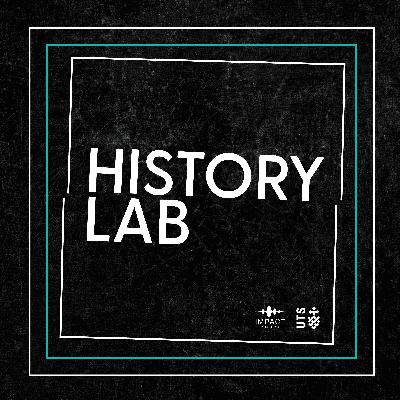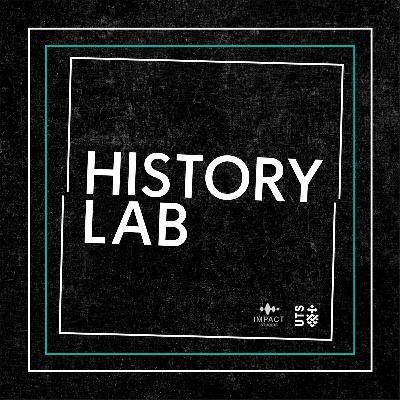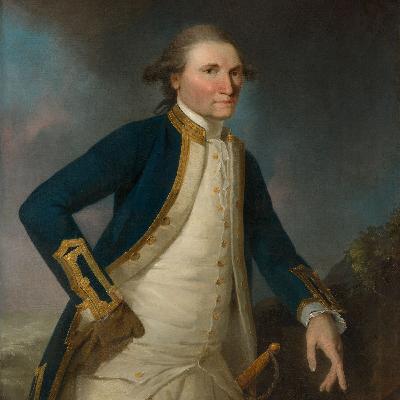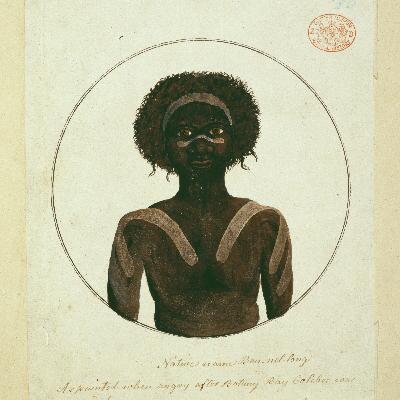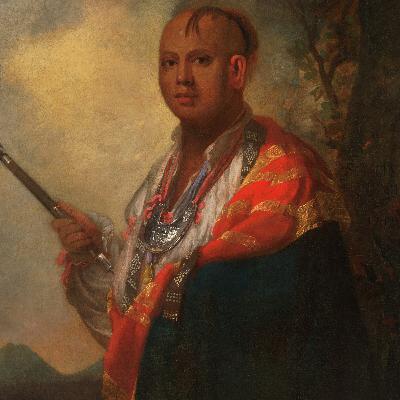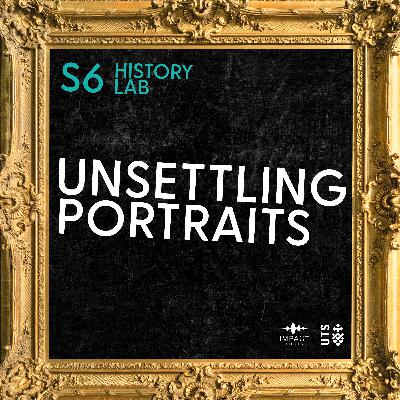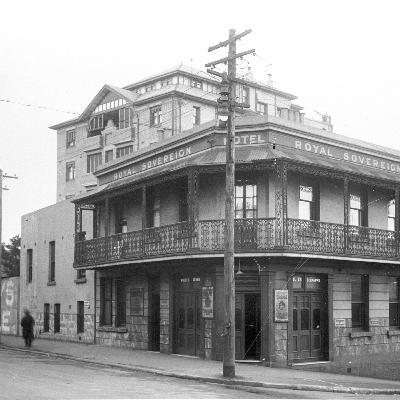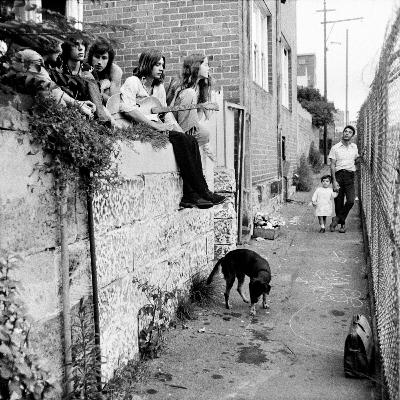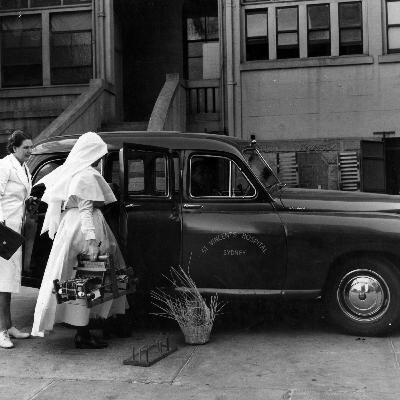Discover History Lab
History Lab

History Lab
Author: Impact Studios
Subscribed: 638Played: 2,828Subscribe
Share
© 2025 UTS Impact Studios and the Australian Centre for Public History
Description
History Lab || exploring the gaps between us and the past || This series is made in collaboration by the Australian Centre for Public History and Impact Studios at the University of Technology, Sydney.
44 Episodes
Reverse
In this special episode of Caribbean Echoes, series producers Ben Etherington and Sienna Brown are in conversation with star Jamaican-Australian actress Zahra Newman and acclaimed playwright Alana Valentine. They discuss the making of the series and how performance emerged as a key theme across it. Zahra reflects on being a Black Caribbean-Australian actor today, and the persistence of the racial politics that afflicted earlier generations of Caribbean immigrants. Alana takes us through the joys of bringing Nellie Small, the subject of History Lab episode 33, back to the stage in her cabaret Send for Nellie! And we hear about Nellie’s solidarity with Indigenous performers. The panel also talks bloopers and highlights from their performing careers in this conversation recorded in a packed room at the Abercrombie Hotel in Sydney on October 23, 2025. Guests Zahra Newman was born in Port Antonio, Jamaica, and moved to Australia at age 14. A graduate of the Victorian College of the Arts, Newman has an extensive list of credits in theatre, television, and film. Notable works include her performance as Nabalungi in the original Australian cast of The Book of Mormon, and her lead role in the adaptation of Maxine Beneba Clarke’s memoir The Hate Race. She has received a Green Room Award, a Sydney Theatre Award, and multiple Helpmann Award nominations. Newman played all 23 characters in the Sydney Theatre Company’s recent one-person production of Dracula. Alana Valentine is a librettist, playwright, and director who has had a long and celebrated career. One highlight is working with acclaimed First Nations performer, Ursula Yovich, on Barbara and The Camp Dogs, which toured nationally, was the recipient of four Helpmann Awards including Best Original Score and Best Musical and four Green Room Awards in Melbourne. She’s collaborated with the First nations choreographer and director Stephen Page on eight works including the multi-award winning Bennelong and the Opera ceremony Baleen Moondjan, which has just played the Brisbane Festival in 2025. Her cabaret Send For Nellie, which repositioned vaudeville legend Nellie Small in the Queer cultural firmament, debuted at the Sydney Festival in 2024. Jamaican-born Sienna Brown writes historical fiction that centres on the Caribbean Experience in Australia. Her novel Master of My Fate (2019), won the MUD Literary Prize at Adelaide Writers Week for the best debut novel and was shortlisted for the ARA Historical Novel Prize. In 2021, she was commissioned by ABC Radio National to create Caribbean Convicts in Australia. Since 2022, she's been a Research Associate at Western Sydney University as part of the ARC Discovery Project Creole Voices in the Caribbean and Australia. Ben Etherington is an associate...
Hear author and historian Katherine Biber tell the story of Jimmy and Joe Governor, Wiradjuri and Wonnarua brothers, who in 1900 went on a murder spree that killed nine people and terrified countless others. The men were pursued for three months across 3000 kilometres, taunting their hunters with clues, letters and tricks. The last men in the state to be proclaimed outlaws, their pursuit and capture fascinated and terrified a nation on the eve of its Federation.Back in 2021, History Lab published its award-winning Last Outlaws episodes (you can find them in eps 15-17) - a collaboration with Biber and the Governor family. Now, Biber has told the story in a book. In this episode, she speaks with historian Alecia Simmonds about the connection between the fate of the Governor brothers and the birth of modern Australia. The Last Outlaws: The crimes of Jimmy & Joe Governor and the birth of Modern Australia is published by Simon & Schuster. It is the product of decades of archival research, field work and interviews, and of a long collaboration with Jimmy Governor’s descendants.This episode is brought to you in partnership with our friends at Gleebooks. Head to the Gleebooks events page to discover more great literary events featuring some of Australia’s best and best known authors. GuestsKatherine Biber is a writer, legal scholar, criminologist, historian and Professor of Law at UTS. Katherine undertook the research for The Last Outlaws in cooperation with descendants of Jimmy Governor. Her History Lab podcast trilogy, made as part of this collaboration, won multiple awards, including the NSW Premier’s History Award, the Australian Podcast Award (2022 podcast of the year) and the Australian Legal Research Award.Katherine teaches and researches Evidence. Her scholarly interests lie in photographic evidence, documentary evidence, criminal evidence and histories of evidence.Alecia Simmonds is a multi-award winning scholar and writer who works at the interface of law and history. Her most recent book Courting: An Intimate History of Love and the Law won the NSW Premier's Prize for best book in Australian history, the Australian Law Research Awards for best book, the biennial Hancock Prize for best book and the Australian and New Zealand Legal History award for best book 2023. It was also shortlisted for the Prime Minister's Award and the Ernest Scott Award. CreditsFully Lit is made by Impact Studios, a media production house based on Gadigal land at UTS, Sydney. This episode was recorded at Sydney's Gleebooks, also on Gadigal land.
What connects a VFL “Champion of the Colony” to a woman born enslaved in Jamaica?In 1919, Richmond footballer Vic Thorp won the league’s highest honour for the second time — the equivalent of today’s Brownlow Medal. But just a century earlier, his great-grandmother Susannah Andrews was enslaved in Jamaica, before gaining her freedom.This episode uncovers Susannah’s remarkable journey: from enslavement, to freedom, to becoming matriarch of an Australian family that would include football legends and mining startups.We hear from her descendant Garry Chapman, who discovered Susannah’s story while sifting through his father’s papers. Jamaican historian Suzanne Francis-Brown — a regular on the BBC’s Who Do You Think You Are? — helps us reconstruct Susannah’s life as an enslaved, then free, woman living with a Jewish merchant in Kingston.So how does one woman’s survival ripple through generations? And why does remembering Susannah’s life matter for how we tell Australian history today?VoicesGarry Chapman taught in both primary and secondary sectors and worked in both government and independent schools over a career of 42 years. He is the author of over 50 published books, written for children and teachers. Garry developed an interest in his own family’s history when he found a folder full of notes in his late father’s belongings. It contained a photo of his great great grandfather, George Brydon Brandon with ‘Jamaica?’ written on the back. This planted a seed, and Garry has spent the ensuing years trying to fill in the missing pieces of his ancestors’ stories, uncovering the fascinating tale of Susannah Andrews in the process.Historian Dr Suzanne Francis-Brown has worked as a journalist, lecturer in media and communications and museum curator. Her research interests include heritage interpretation, enslaved families, and enslaved runaways in Jamaica, and she has published Mona, Past and Present: The History and Heritage of the Mona Campus, University of the West Indies (2004) and the co-authored The Old Iron Bridge, Spanish Town, Jamaica, (2005), as well as several works of youth fiction. She was curator at the University of the West Indies Museum from its founding in 2012 to 2019. Dr Francis-Brown has featured many times on the BBC’s Who Do You Think You Are? Credits This series was produced on the lands of the Gadigal people of the Eeora Nation and Burramatagal people of the Dharug nation. Narrator, writer, and producer: Sienna Brown Sound recordist, writer, and producer: Ben Etherington Supervising producer: Jane Curtis, UTS Impact StudiosExecutive producer: Sarah Gilbert, UTS Impact StudiosSound designer and engineer: John Jacobs SupportThe research for this series was funded by the Australian Research Council Discovery Project Creole Voices in the Caribbean and Australia: Poetics and Decolonisation (DP220101256). We are also grateful to the a...
Who was the Caribbean-Australian cabaret star who could bring down the house — and come back at racism with a joke? "Come sit by me, we don’t eat people anymore."Nellie Small was born in Sydney in 1900, just before the White Australia policy was introduced. She became one of the country’s most beloved performers, famous for wearing men’s suits on stage and off, and for her sharp comebacks. In show business circles around Sydney in the 1940 and 50s, the phrase was: “When a show’s not strong enough — send for Nellie!” "I’m proud of my Australian birth. But I’d be much happier if more of my fellow countrymen would forget my skin colour is different from them."Negotiating Australia’s vexed racial politics, Nellie carved out a public space for Black music and queer performance in 1950s Australia. We explore her career and uncover the previously unknown stories of her Caribbean forebears. Nellie Small is played by Jamaican-Australian actor Zahra Newman. VoicesAlana Valentine is a librettist, playwright, and director who is an expert at working with real life subjects and stories, dramatizing them with respect. She has three plays on the NSW HSC Syllabus: Parramatta Girls, Shafana and Aunt Sarrinah, and Cyberbile. Her play, Letters to Lindy, has seen hundreds of amateur and school productions. Valentine is particularly distinguished in her skills as a co-collaborator, notably with Barbara and the Camp Dogs, which won the 2019 Helpmann Award for Best Musical and Best Original Score. She has chronicled her practice in Bowerbird and published the memoir Wed By The Wayside. Professor Cassandra Pybus FAHA specializes historical narratives about people who have been marginalized, forgotten or written out of history. An award-winning author she has published 13 books including Black Founders: The Unknown Story of Australia's First Black Settlers and the bestselling biography, Truganini. She has held research professorships at the University of Sydney, Georgetown University in Washington DC, the University of Texas and King's College London. She is descended from a colonist who received the largest free land grant on Truganini's traditional country of Bruny Island. Vanessa Cassin is Education Manager at Society of Australian Genealogists with extensive experience in providing training and assessment in the trustee industry, both as an in-house trainer for the NSW Trustee & Guardian and as an assessor for Western Sydney University the College’s Registered Training Organisation. Vanessa holds a Diploma in Family Historical Studies from the Society of Australian Genealogists and has been researching her own family history for over 20 years. Zahra Newman was born in Port Antonio, Jamaica, and moved to Australia at age 14. A graduate of the Victorian College of the Arts, Newman has an extensive list of credits in theatre, television, and film. Her notable works include her performance as Nabalungi in the original Australian cast of The Book of Mormon, and her lead role in the play The Hate Race and in the film Long Story Short. She has received a Green Room Award, a Sydney Theatre Award, and multiple...
What does boxing have to do with anticolonial politics? How did the sport become a space where Black and Indigenous fighters in Australia pushed back against racism and empire?From Peter Jackson to Jack Johnson, Marcus Garvey to Les “Ranji” Moody, this episode explores how Black and Indigenous fighters turned the ring into a stage for resistance and anticolonialism.Worimi historian Professor John Maynard talks about the links between Jackson and the first official Black heavyweight world champion Jack Johnson, whose world-title fight took place in Sydney in 1908. Maynard’s grandfather spent time with Johnson, and he talks about how Johnson’s time here links to the later emergence of anticolonial politics among Indigenous people inspired by the Jamaican Marcus Garvey.We then talk to Aboriginal author Tony Birch about his Barbadian ancestor Prince Moody, who was transported to Australia as a convict for ‘disobedience’, and his great uncle Les ‘Ranji’ Moody, who Birch knew growing up in Fitzroy. Les was a pathbreaking boxer and journalist who was the Australian bantamweight champion during the First World War. Birch discusses how oral history and creative engagements with the colonial archive can recover marginalized stories.Voices Professor John Maynard is recognized as one of Australia's foremost Indigenous historians, whose work reveals previously missing chapters in Aboriginal history. His groundbreaking research on Aboriginal political activism in the 1920s uncovered the influence of Caribbean and African American figures, particularly Marcus Garvey. Maynard has written acclaimed books, including Fight for Liberty and Freedom and The Aboriginal Soccer Tribe, a Walkley Award finalist. He has held prominent positions, such as Director of the Wollotuka Institute and Deputy Chairperson of AIATSIS, and is a recipient of numerous fellowships and awards. Professor Tony Birch is a writer, activist, historian and essayist, and is currently the Boisbouvier Chair in Australian Literature at the University of Melbourne. He has published four novels, most recently Women & Children, which won the 2024 The Age Fiction Book of the Year. Each of his novels has won major prizes and he’s twice been shortlisted for the Miles Franklin Literary award. He has also published two poetry books and four short story collections, the most recent of which, Dark as Last Night, won both the 2022 NSW Premier’s Literary Award and the Queensland Literary Award for Fiction. Credits This series was produced on the lands of the Gadigal people of the Eeora Nation and Burramatagal people of the Dharug nation. Narrator, writer, and producer: Sienna Brown Sound recordist, writer, and producer: Ben Etherington Supervising producer: Jane Curtis, UTS Impact StudiosExecutive producer: Sarah Gilbert, UTS Impact StudiosSound designer and engineer: John Jacobs/jollyvolume SupportThe research for this series was funded by the
Did you know that the most famous Australian in the world in 1890 was from the Caribbean?Peter Jackson was born in St Croix in the Caribbean in the years after slavery was abolished. He arrived in Sydney as a teenager and got noticed when he single-handedly fought off seven in a brawl at Wynyard Square.He soon stepped into Sydney’s boxing rings and, by 1890, he was Australia’s heavyweight champion and chasing the world title in the United States.But he was no ordinary boxer. He moonlit as an actor, quoted Shakespeare, and was a media pioneer, carefully shaping his own public image long before Instagram.In this episode, award-winning sports journalist Grantlee Kieza charts Jackson’s rise through the boxing world, while cultural historian Professor Jordana Moore Saggese explains how he mastered self-presentation through photography and mass media. Historian Myron Jackson brings us back to St Croix, where Peter’s colonial schooling met the lessons of the street.Peter Jackson’s story is about much more than boxing — it’s about race, representation, and the adaptability and durability of Caribbean culture.Peter Jackson is played by British-Sierra Leonean actor Alpha Kargbo.VoicesGrantlee Kieza OAM is an award-winning journalist who specialises in historical Australian stories. He has published more than twenty biographies, many of them bestsellers, and held senior editorial positions at The Daily Telegraph, The Sunday Telegraph and The Courier-Mail. He is a Walkley Award finalist, a 2025 ABIA shortlisted author for Biography of the Year, a 2025 Indie Award shortlisted author for Non-fiction, the No. 1 history author in Australia in 2024. Jordana Moore Saggese is Professor of Modern and Contemporary American Art at the University of Maryland, College Park whose research focuses on modern and contemporary American art and photography, with an emphasis on expressions of Blackness. She is the author of The Jean-Michel Basquiat Reader: Writings, Interviews, and Critical Responses, and her most recent book Heavyweight: Black Boxers and the Fight for Representation (Duke University Press, 2024) engages extensively with Peter Jackson. Myron Jackson is a historian and retired Senator who has dedicated his life to Virgin Islands history and culture, guided by the African proverb, “Go Back And Fetch It”. A graduate of Parsons School of Design, he held significant positions including Director of the Virgin Islands State Historic Preservation Office and executive director of the Virgin Islands Cultural Heritage Institute. As a Senator, Jackson served as the Chair of the Committee on Culture, Historic Preservation, Youth and Recreation. He has researched and published widely in preservation. Alpha Kargbo is a British-Sierra Leonean actor trained at the Royal Welsh College of Music & Drama. His theatre work spans the UK, Europe, and Australia, including The Da Vinci Code (UK Tour), Malthouse Theatre, and Melbourne Theatre Company. On screen he has appeared in Bloods (Sky UK) and The Undeclared War (Channel 4),...
History Lab is back—refreshed and reimagined. From now on, you’ll hear us in regular seasonal runs, dropping new episodes once or twice a fortnight over six to eight weeks. Each run will showcase a mix of formats:History Lab Originals – our signature investigative storytelling that digs into the gaps between us and the past.History Lab Studio – interviews and discussions with historians.History Lab Live – recordings of public history talks from libraries, bookshops, and university halls, where history meets its audiences.This new approach means more variety, more regularity, and more ways to connect with the history that shapes our world.What’s in this run?ORIGINALS Caribbean Echoes: A powerful four-part History Lab Original by Sienna Brown and Ben Etherington that uncovers the lives and legacies of Caribbean people in Australia, including boxer Peter Jackson and cabaret star Nellie Small.LIVE David Scott Mitchell Oration: ABC Chair Kim Williams reflects on the role of libraries and archives in preserving truth and democracy.LIVE The Last Outlaws: Professor Katherine Biber discusses her gripping new book on crime, justice, and truth telling.Why this mattersSince 2018, History Lab has produced 29 episodes across six seasons, exploring not only what happened in the past, but how we can know about it. Now, in a crowded world of podcasts, we’re focusing on what makes us different: investigative history, bold conversations, and live public storytelling.By listening and sharing, you’re helping build a platform for public history in Australia, something we need now more than ever. Thank you.Host: Tamson Pietsch, Director of the Australian Centre for Public HistoryExecutive Producer: Sarah GilbertProduced on Gadigal land at UTS, Sydney by Impact Studios.
What is the work of truth-telling? How is evidence collected? What happens next?What role should schools play in teaching Australia’s full history? Australia has completed its first, formal truth-telling process — the Yoorrook Justice Commission of Victoria. We joined Commissioner Travis Lovett on his 500-kilometre Walk for Truth from Portland on Gunditjmara Country, to Parliament House on Wurundjeri Woi-wurrung Country in Melbourne, to hear firsthand of the Commission's work.Along the way, you'll hear testimonies from Elders and Victorian Premier Jacinta Allan, reflections from researcher Dr Matthew Keynes, and insights into how truth-telling can transform education, policy, and our shared future.GuestsTravis Lovett is a proud Kerrupmara/Gunditjmara man and Traditional Owner and the Deputy Chair and Commissioner of the Yoorrook Justice Commission.Dr Matthew Keynes is a non-Indigenous scholar working on unceded and sovereign Wurundjeri land. His research investigates the ways that education contributes to justice, peace, and social transformation by repairing historical injustices and legacies of violence.LinksYoorrook Justice Commission Truth ArchiveYoorrook Justice Commission Reports and RecommendationsWe have always been here by Dr Matthew KeynesNational Indigenous Youth Education CoalitionTruth-telling in early education by Gowrie VictoriaDay Break by Amy McQuireHow do you prepare your child for truth-telling? by Shelly WareTeaching truth-telling: Children's Ground panel on YouTubeCreditsProduced on Gadigal and Gunditjmara Country by Jane Curtis.Sound engineering by Jollyvolume.Production assistance from Alexandra Morris.Hosted by Tamson Pietsch.History Lab is produced by the Australian Centre for Public History at UTS and UTS Impact Studios. Impact Studios' executive producer is Sarah Gilbert. Thank youThis episode was made possible by Dusseldorp Forum, a family foundation committed to a just and equitable Australia, one that is caring, ethical and honours our First Peoples. Special thanks to Rachel Fyfe and the Yoorrook team.
This special episode from our archives speaks to this year’s NAIDOC Week themes of strength, vision and legacy.Fishing for Answers explores the sophistication of the fishing practices of Eora women in Sydney Harbour, and asks, How can we hear from the women themselves and find out what their world sounded like? Content warning: If you are an Aboriginal or Torres Strait Islander person this episode may contain the names of people who have died.CreditsProducers: Tom Allinson and Ninah Kopel Collaborators: Anna Clark, Nathan Sentance, Tim Ella and Maddison Lyn CollierExecutive Producer: Emma LancasterAssociate Producer: Anna ClarkSound Design: Joe KoningHost: Tamson PietschVoice Actor: Steve AhernAdditional production assistance: Ellen Leabeater and Miles HerbertMarketing and communications: Andy HuangThanks to Les Bursill OAM for his advice on the Darug language, and Grace Karskens and Renee Cawthorne.This episode was made on Gadigal Country.
Colonial portraits have long dictated how Indigenous people were seen. But Indigenous artists continue to challenge that power. Through satire, reinterpretation, and resistance, they’re using art to question history—and reshape the future. In this episode, historians Kate Fullagar and Mike McDonnell speak with contemporary Indigenous artists who are confronting the legacy of empire. Michel Tuffery, a New Zealand-based artist of Samoan, Tahitian, and Cook Islander heritage, reimagines Captain Cook through the eyes of those he encountered. Daniel Boyd, one of Australia’s most celebrated contemporary artists, subverts colonial iconography, turning figures like Cook into symbols of piracy and exploitation. Daniel Browning, an Aboriginal journalist and art critic, reflects on the power—and the lies—embedded in colonial paintings. Can art break the cycle of representation, or does it always carry the weight of its past? Join us on this final episode of Unsettling Portraits to find out. Episode images Cookie in the Islands This representation of Captain James Cook belongs to a narrative series titled ‘First Contact’. The series retells the story of James Cook’s Pacific voyages from a Polynesian perspective, focusing on the profound way in which Cook himself was altered through his experiences in the Pacific. His identity is altered, as marked by hibiscus flowers, hei-tiki around his neck and his Polynesian features. The name Cookie is not only a more familiar name for Captain Cook but it is also a nickname for a Cook Islander. (Curator's comments) By Michel Tuffery. 2009. British Museum. Portrait of Captain James Cook RN By John Webber, 1782. National Portrait Gallery Australia Captain No Beard By Daniel Boyd, Kudjla/Gangalu/Kuku Yalanji/Jagara/Wangerriburra/Bandjalung peoples, 2005. National Gallery of Australia. Nannultera, a young Poonindie cricketer By J.M. Crossland, 1854. National Gallery of Australia. Portrait - Eva Johnson, writer By Destiny Deacon, 1994. Queensland Art Gallery. Guests Michel Tuffery, a New Zealand-based artist of Samoan, Rarotongan, and Ma’ohi Tahitian heritage, creates work that bridges environmental, cultural, and historical divides. Known for his role as a connector between people and places, he engages communities through exhibitions, research, and residencies across the Pacific and beyond. A passionate educator, he shares his kaupapa and knowledge with young people through workshops in New Zealand and abroad. Appointed a Member of the New Zealand Order of Merit in 2008 for his contributions to art, he continues to enrich communities through his creative practice. Daniel Boyd, one of Australia’s leading artists, is a Kudjala, Ghungalu, Wangerriburra,
In this episode, historians Kate Fullagar and Mike McDonnell revisit Bennelong’s portraits to examine how colonial art encountered Indigenous identity. Indigenous scholar Jo Rey, a Dharug woman, challenges these depictions, questioning their accuracy and impact. The conversation then expands to the Pacific, where Māori scholar Alice Te Punga Somerville discusses the story of Tupaia, a Polynesian navigator and artist who traveled with Captain Cook. His illustrations of first contact tell a different story—one of Indigenous agency, not just European discovery. What do we see when we look at these portraits today? And more importantly, what do they obscure? Join us on Unsettling Portraits to find out. Episode images Ben-nel-longBy the Port Jackson Painter, c. 1790. Watling, Thomas. Courtesy of the Natural History Museum, London.Ben-nil-long By James Neagle, 1798. Courtesy National Library of Australia. Australian Aborigines paddling bark canoes and spear fishing DRAWINGS, in Indian ink, illustrative of Capt. Cook's first voyage, 1768 -1770. This may record the fishing party observed by Joseph Banks at Botany Bay on 26 April 1770. By A. Buchan, John F. Miller, and others. Courtesy British Library. A Maori bartering a crayfish with an English naval officer DRAWINGS, in Indian ink, illustrative of Capt. Cook's first voyage, 1768 -1770, chiefly relating to Otaheite and New Zealand. By A. Buchan, John F. Miller, and others. Courtesy British Library. Guests Jo Rey is a Dharug scholar and Macquarie University Fellow for Indigenous Researchers in the Department of Indigenous Studies. Her research focuses on Dharug Ngurra/Country, which spans much of the Sydney metropolitan area, examining key cultural sites, including Shaw’s Creek Aboriginal Place and the Blacktown Native Institution. Building on her doctoral research on Dharug cultural continuity, her post-doctoral work explores Indigenous cultural agency through the concept of ‘Living Law’—a framework of sustainable relationality based on Recognition, Respect, Rights, Responsibility, and Reciprocity. Alice Te Punga Somerville (Māori – Te Āti Awa, Taranaki) , professor of English Language and Literatures at the University of British Columbia, is a poet, scholar, and irredentist whose work explores Indigenous connections, colonial histories, and the power of language. She is the author of Once Were Pacific: Māori Connections to Oceania, 250 Ways to Write an Essay about Captain Cook, and the poetry collection Always Italicise: How to Write While Colonised, each challenging dominant narratives and centering Indigenous perspectives. Credits Producers: Catherine Freyne and Helene Thomas. Story Editor: Siobhan McHugh Sound Engineer: Martin Peralta Additional production and editorial support: Jane Curtis, Britta Jorgensen and Celine Teo-Blockey Additional tile...
Bennelong, a Wangal man of the Eora nation, was among the first Aboriginal people to travel to Europe and return. As a crucial interlocutor between his people and the British colonists, he navigated two worlds but the way he was depicted in colonial portraits raises complex questions. In one, he appears in traditional body paint. In another, years later, he is dressed in European clothing, his identity seemingly reshaped for a colonial gaze. Do these portraits tell us more about Bennelong or the people who painted him? Portraiture has long been a tool of empire, used to categorize, control, and mythologize. But can these images also reveal Indigenous agency? In this first episode, historians Kate Fullagar and Michael McDonnell visit the National Portrait Gallery to examine Bennelong’s likeness and trace a broader history of representation. They are joined by Anishinaabe writer Gordon Henry, who reflects on 17th-century depictions of Indigenous North Americans, and Cherokee scholar Joseph Pierce, who challenges the sanitized portrait of Cherokee diplomat Ostenaco. Who really controls the stories that portraits tell? And how do these images continue to shape our understanding of Indigenous identity today? Join us on Unsettling Portraits to find out. Episode Images Bennelong Drawing 41 from the Watling Collection titled 'Native name Ben-nel-long, as painted when angry after Botany Bay Colebee was wounded.’ By Thomas Watling c 1790. Courtesy Natural History Museum London. Portrait of a Famous One-eyed Man By Louis Nicolas, 1675. Codex Canadensis, page 14. Courtesy Gilcrease Museum, Tulsa, Oklahoma USA. Portrait of Syacust Ukah, Cherokee Chief By Joshua Reynolds, 1762. Courtesy Gilcrease Museum, Tulsa, Oklahoma USA. HostsKate Fullagar, professor of history at the Australian Catholic University and Vice President of the Australian Historical Association, specializes in eighteenth-century world history, particularly the British Empire and Indigenous resistance. In her role at the AHA, she advocates for truth-telling in Australian historiography, working to integrate Indigenous perspectives and confront colonial legacies. Through works like Bennelong & Phillip, she engages both academic and general audiences, challenging traditional narratives. Michael McDonnell, professor of Early American History at the University of Sydney, is currently working on several research projects with collaborators, including studies on comparative Indigenous experiences of empire, the American Revolution’s role in Black American life, and memoirs of lower-class Revolutionary War veterans. His work highlights the value of history in fostering diverse perspectives and uncovering new insights about both the past and present. Guests Gordon Henry is a member of the White...
Can colonial depictions of Indigenous people tell us anything useful about the past? How do Indigenous people today feel about these enduring images? Unsettling Portraits is a three-part series exploring the history of portraiture and colonialism, alongside contemporary First Nations responses. Indigenous artists and historians in Australia, the Pacific and North America discuss the practice of colonial portraiture, including Daniel Browning, Jo Rey, Alice Te Punga Somerville, Gordon Henry and Joseph Pierce. And you'll hear about the ways in which contemporary artists like Daniel Boyd, Michel Tuffery and the late Destiny Deacon have turned back the gaze on settlers with their art. Join acclaimed historians Kate Fullagar and Mike McDonnell as they and their collaborators wrestle with the portraits of our colonial past in History Lab Season 6: Unsettling Portraits.CreditsHistory Lab is a UTS Impact Studios production. Producers: Catherine Freyne and Helene Thomas. Story Consultant: Siobhan McHugh Sound Engineer: Martin Peralta Production support: Jane Curtis, Britta Jorgensen and Celine Teo-Blockey Additional tile design and podcast artwork: Alexandra Morris Executive Producer: Sarah Gilbert
If you're an old friend, hello and thank you for hitting play. If you're a new listener, welcome. History Lab, as many of you will know, was Australia’s first investigative history podcast. We've made five seasons so far, and our tagline is exploring the gaps between us and the past. And while you notice that from season to season our storytelling style changes, we're still always asking questions that provoke curiosity, that are attentive to sources and their limits, and that challenge us to think about how we live in the present. Things have been a bit quiet on the History Lab feed lately, so we want share two bits of exciting news, and preview what's coming up in 2025! History Lab season 5 won an international Signal award for the Red Light Green Light episode of Listen to Darlinghurst. And, History Lab had a baby! It’s called Hey History!, and it’s an Australian history podcast for kids and their adults. Each episode explores a different topic, from first meetings at Kamay Botany Bay, to the Gold Rush. This year, there’s three new seasons of History Lab coming your way. First up is Unsettling Portraits, a series that looks closely at the history of portraiture, colonialism, and First Nations responses. You’ll hear historians Kate Fullagar and Mike McDonnell speaking with Indigenous scholars, critics and artists about what these pictures mean today. Ancestral Echoes is a second History Lab season hosted by researcher, producer and historical novelist Sienna Brown. Brown hails from Jamaica, and across three episodes, she explores the stories of some significant but little-known Caribbean Australians. In unearthing these stories, she’s looking for a connection with the past that will help her feel more at home here. And in a third History Lab series, historian Leigh Boucher explores the untold histories of the HIV epidemic in Sydney in the 80s and 90s. The series tells the story from a new perspective, focusing in on the very tight but by no means homogenous 'gaybourhood' of Darlinghurst. History isn’t the only thing we do here at Impact Studios, of course. You can hit play on the three-part narrative podcast Sink or Swim, where host Angelica Ojinnaka Psillakis learns to swim as an adult and works out how to survive in our ever hotter suburbs. And for lovers of books and as well as history, check out Fully Lit - a new podcast about Australian books. The trailer's out and episodes release soon.
A special History Lab episode with a soundwork that explores the history of Sydney's South Head, followed by an interview with the maker Sinead Roarty and Director of the Australian Centre for Public History at UTS, Tamson Pietsch.About the soundwork: On the EdgeThe Gap at South Head in Sydney's eastern suburbs is a place of extreme beauty. It is also famous for being Australia's most well-known suicide destination.On the Edge is a long-form binaural/VR soundwork exploring South Head’s spatial history and its varied conflicting narratives. The work addresses multiple levels of ‘silencing’ from the time of colonial contact and uses sound to give a voice to the unheard. South Head's ruptured history has shaped the perception of it in the past and this soundwork suggests a way to reanimate it in the present.The thirteen-minute soundwork is best experienced at the Don Ritchie Grove, located a few minutes’ walk from The Gap lookout and can be accessed on a mobile phone from the website https://www.ontheedge.space/On the Edge was created as part of a non-traditional PhD at the University of Technology Sydney. The PhD was subsequently recognised as the best doctoral thesis from the Faculty of Arts and Social Sciences in 2023 and was included on The Chancellor's List, which recognises ‘exceptional scholarly achievement in PhD research’.On the Edge transcript Word doc transcript PDF transcript On the Edge Credits Writer/Director: Dr Sinead Roarty Primary Supervisor: Dr Delia Falconer Alternate Supervisor: Assoc Professor Debra Adelaide Sound Studio: MassiveMusic For all credits see https://www.ontheedge.space/ Episode creditsSound engineering: Simon BranthwaiteEpisode image photo by Sinead Roarty.History Lab is a production of UTS Impact Studios.
We've got a new history podcast for you and the kids in your life, called Hey History! With immersive, sound rich storytelling and Australia's top historians and experts, dive into key events in our history.Find out... How did First Nations people learn on Country? How does learning happen today? What really when Captain Cook and First Nations people met at Kamay Botany Bay? What was life like as a convict kid? How did you remember your loved ones? How did everyone get along in the Gold Rush? In each episode, kids from around Australia share questions, ideas and reflections on our history. Hey History! aligns with the upper primary curriculum, so teachers can use it in class.The Bonus episode answers your questions on how to talk with kids about Australian history, and answer curly questions. Hey History! is made by Professor Anna Clark, a previous guest on the History Lab, Professor Clare Wright OAM, and the team at UTS Impact Studios. Subscribe, get Learning Materials and more on the Hey History website http://heyhistory.net or in your podcast app.
In 1887 there were no less than 22 hotels in Darlinghurst. Over the next century and a half, the character, culture and clientele of Darlinghurst pubs evolved. This story explores the impact on Darlinghurst of two episodes of liquor licensing restrictions in NSW: six o’clock closing and the Sydney lockout laws. Image: Royal Sovereign Hotel, corner Darlinghurst Rd and Liverpool St, 1921 (City of Sydney Archives) Credits This audio story is a production of the Australian Centre for Public History in partnership with the Paul Ramsay Foundation. Producer: Catherine Freyne Sound engineer: Judy Rapley Music: Blue Dot Sessions When Paris is Singing by Dazie Mae licensed under CC by NC-SA 3.0 US Archival: ABC Content Sales Featuring: Paul Solomon, publican’s son and grandson Max Burns-McRuvie, owner of Journeywalks Tyson Koh, founder of Keep Sydney Open
Terraces, flats, squats, bedsits, mansions, towers, camps and hostels: in Darlinghurst, housing is a mixed bag. This audio story explores the range of lifestyles afforded by Darlinghurst’s dense diversity of dwellings. Image: Pad with a View, Kings Cross 1970-71 (Photographer: Rennie Ellis © Rennie Ellis Photographic Archive) Credits This audio story is a production of the Australian Centre for Public History in partnership with the Paul Ramsay Foundation. Producer: Catherine Freyne Sound engineer: Judy Rapley Music: Blue Dot Sessions Sum of My Fears, When Paris is Singing and A New Love Affair by Dazie Maelicensed under CC by NC-SA 3.0 US Garage by Monplaisir licensed under CC by CC0 1.0 Korobushka by the Rosen Sisters licensed under CC by NC-ND 4.0 Featuring: Jan Cornall, former resident of Darlinghurst squats Paul Solomon, publican’s son and grandson Phillip Adams, former owner of Stoneleigh Shannon Dalton, former Assistant Manager of the Darlo Bar
At St Vincent's Hospital, the Sisters of Charity have been delivering care to the people of Darlinghurst since 1857. This audio story visits St Vincent’s during three historic public health emergencies: the Spanish Flu, the HIV/AIDS crisis and COVID-19. Image: Sister and nurse with home visitation car, St Vincent’s Hospital, Sydney (Courtesy of the Congregational Archives of the Sisters of Charity of Australia) Credits This audio story is a production of the Australian Centre for Public History in partnership with the Paul Ramsay Foundation. Producer: Catherine Freyne Sound engineer: Judy Rapley Music: Blue Dot Sessions; The Tudor Consort licensed under CC by 3.0 Archival: ABC Content Sales Featuring: David Polson, former patient at Ward 17 South at St Vincent’s Hospital, Sydney. Erin Longbottom, Nursing Unit Manager, Homeless Health Outreach Service, St Vincent’s Hospital, Sydney. An excerpt from St Vincent’s Hospital Annual Report 1919 read by Marie Freyne.
In the rapidly gentrifying Darlinghurst of the 1980s, a turf war raged over one of its earliest trades. In this story, we visit the street corners and safe houses where sex workers competed for customers, looked out for each other and stood their ground. Along the way, veterans of the street-based trade describe a changing industry, sharing stories from the frontline of the fight for law reform and workers’ rights. If you would like to sign the petition to bring the statue of Joy back to Darlinghurst, visit http://tiny.cc/dfhavz Image: Woods Lane 1968 (Tribune negative; Mitchell Library, State Library of New South Wales courtesy SEARCH Foundation) Credits This audio story is a production of the Australian Centre for Public History in partnership with the Paul Ramsay Foundation. Producer: Catherine Freyne Sound engineer: Judy Rapley Music: Blue Dot Sessions Archival: ABC Library Sales Featuring: Julie Bates, veteran sex worker activist; Principal of Urban Realists Planning and Health Consultants. Chantell Martin, veteran sex worker; Co-CEO of Sex Workers Outreach Project.


![36. [Caribbean Echoes 5]: Live from the Abercrombie with Zahra Newman and Alana Valentine 36. [Caribbean Echoes 5]: Live from the Abercrombie with Zahra Newman and Alana Valentine](https://s3.castbox.fm/fb/89/93/336d3be76c53314226019d2994136ecf2a_scaled_v1_400.jpg)
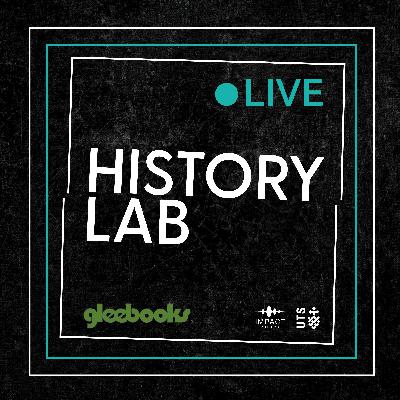
![34. [Caribbean Echoes 4] Susannah Andrews: Jamaican Matriarch to Footy Legends and Mining Startups 34. [Caribbean Echoes 4] Susannah Andrews: Jamaican Matriarch to Footy Legends and Mining Startups](https://s3.castbox.fm/18/17/fc/67a0760310fc401ab1214125f09f0c1abf_scaled_v1_400.jpg)
![33. [Caribbean Echoes 3] Nellie Small: Queer Black Caribbean-Australian Icon 33. [Caribbean Echoes 3] Nellie Small: Queer Black Caribbean-Australian Icon](https://s3.castbox.fm/52/c5/cd/fa802242602844158e8ef3120130684fd9_scaled_v1_400.jpg)
![32. [Caribbean Echoes 2] From slavery to anticolonialism: John Maynard and Tony Birch on Black and Indigenous boxing 32. [Caribbean Echoes 2] From slavery to anticolonialism: John Maynard and Tony Birch on Black and Indigenous boxing](https://s3.castbox.fm/c0/dc/a0/0935c7f690c1c0be0689848dcdcad33fbf_scaled_v1_400.jpg)
![31. [Caribbean Echoes 1] Peter Jackson: Boxing Champion and Innovator in Black Self-Representation 31. [Caribbean Echoes 1] Peter Jackson: Boxing Champion and Innovator in Black Self-Representation](https://s3.castbox.fm/32/b1/c8/1db33a40ae4e82e7feb0b981c6202fada7_scaled_v1_400.jpg)
